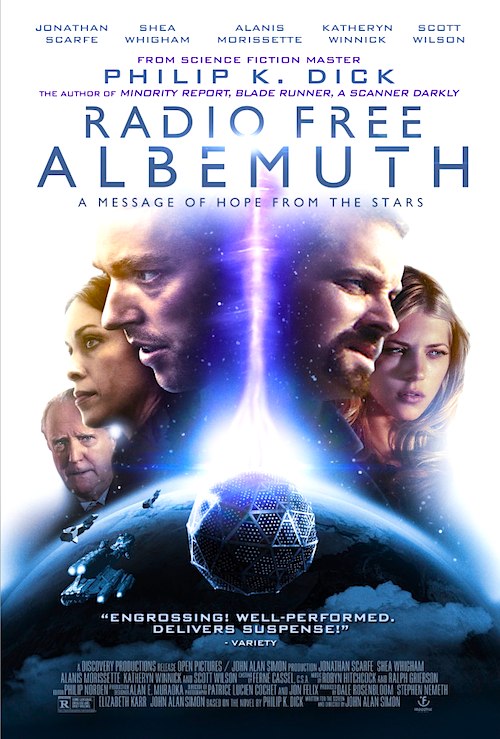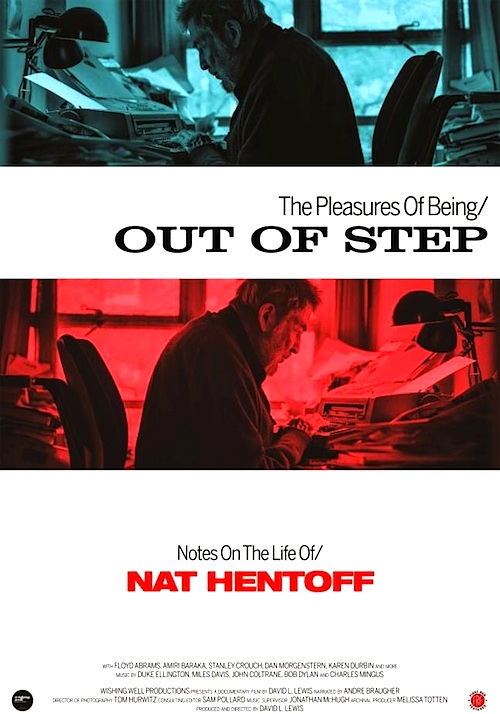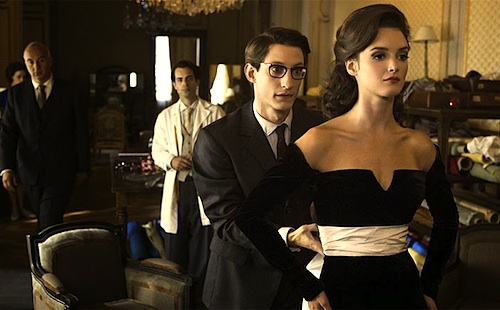By Joe Bendel. Transrealism is a sub-genre of science fiction in which the author frequently appears as a character in their own work, freely melding the fantastical and the autobiographical. The style has several proponents, but they are all largely swimming in Philip K. Dick’s wake. Amongst his most transreal works were his VALIS trilogy and a related posthumous novel. While many Dick novels have been loosely adapted for the screen, the courageous John Alan Simon took a shot at a comparatively faithful take on the more self-contained latter novel. Things will get all kinds of transreal in Simon’s Radio Free Albemuth, which opens this Friday in New York.
In this alternate world, America is a crypto-fascist state, but ironically there is less intrusive surveillance afoot than under the Obama Administration. President (for life) Ferris F. Fremont (FFF = 666) continues to be re-elected despite his bizarre campaign against “Aramcheck,” a supposed shadowy cabal of Soviet sleeper agents still conspiring against the country, years after the fall of Communism. Science fiction novelist Philip K. Dick will chronicle his pal Nicholas Brady’s ill-fated attempt to foment an uprising against Fremont. We know it will be ill-fated because of the decidedly dystopian framing device.
Frankly, the Orwellian state was working quite well for Brady, at least for a while. Thanks to subliminal messaging sent to him by a hive-mind alien entity he dubs VALIS (Vast Active Living Intelligence System), Brady leaves his Berkley record store gig in favor of a position at a record label, where he quickly advances. Due to his previous visions, he is convinced he should sign the mysterious Sylvia to a recording contract when she applies for a receptionist position. She has no idea what he is talking about, but appreciates any opportunity because of her unfortunate surname: Aramcheck.
 Eventually, we learn those who commune with VALIS have an egg implanted in their heads, the Roman Empire never really fell, but continues to be the power behind the curtain, and perhaps Fremont was a Manchurian Candidate-style Soviet plant. Strangely, it all mostly makes sense in context.
Eventually, we learn those who commune with VALIS have an egg implanted in their heads, the Roman Empire never really fell, but continues to be the power behind the curtain, and perhaps Fremont was a Manchurian Candidate-style Soviet plant. Strangely, it all mostly makes sense in context.
Simon goes for a trippy, hallucinatory vibe, but unfortunately he succeeds too well. There is indeed a far-out atmosphere to the proceedings, but that consequently slows the pacing down to a somnambulist shuffle. This also gives viewers more than enough time to fully acknowledge the MST3K-worthy special effects. Frankly, it would be better not to show VALIS’s Satellite of Love than to green screen something that looks cruder than Overdrawn at the Memory Bank.
Clearly, Dick was not holding back the weirdness in Albemuth, yet it now seems somewhat dated, not just in terms of the escalated surveillance. There are weird L. Ronian echoes to the VALIS egg-implants, while Dick’s Cold War disdain seems rather naïve in light of Eastern Europe’s independence movements and Putin’s subsequent Neo-Soviet imperialism. Frankly, the best thing about Simon’s film is the self-reflexively ironic Dick character and the understated but intense performance of Boardwalk Empire’s Shea Whigham.
Albemuth also boasts Alanis Morissette in her first substantial dramatic role, but it is nothing to write home about. Yet, Jonathan Scarfe is even more dour and dull as Brady. At least Hanna Hall seems to enjoy playing the fascist vixen toying with Dick (that doesn’t sound right, but so be it).
As if it needed any stranger credentials, Albemuth also boasts Robyn Hitchcock’s original song “Let’s Party,” which is bizarrely effective playing a critical role within the narrative. In fact, Simon’s ambition is admirable, but there are just too many disparate parts in conflict with each other. It is easy to see why his Hollywood predecessors opted to crank up the action instead. A noble car crash of a film that “Dickheads” will have to see regardless of mere mortal criticism, Radio Free Albemuth opens this Friday (6/27) in New York at the Quad Cinema.
LFM GRADE: C+
Posted on June 26th, 2014 at 5:46pm.




